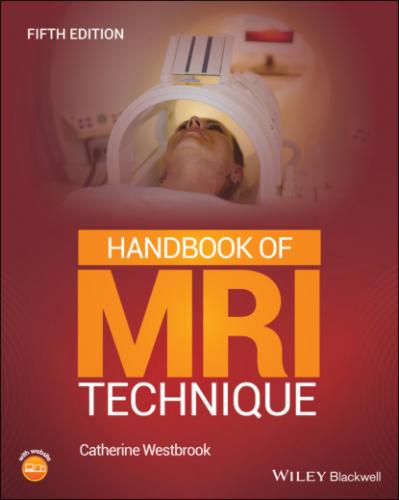This section is subdivided into:
Technical issues: This includes a discussion of the relationship of SNR, CNR, spatial resolution and scan time pertaining to each examination. Suggestions on how to optimize these factors are described (see Protocol parameters and trade‐offs). The correct use of pulse sequences and various imaging options are also discussed (see also Pulse sequences).
Artefact problems: This contains a description of the common artefacts encountered and ways in which they can be eliminated or reduced (see also Flow phenomena and artefacts).
PATIENT CONSIDERATIONS
This encompasses the condition of the patient, including symptoms and claustrophobia. Suggestions to overcome these are given (see also Patient care and safety).
CONTRAST USAGE
The reasons for administering a contrast agent in each examination area are discussed. The use of contrast agents varies widely according to radiological preferences. This section should be used as a guide only (see also Contrast agents).
SUMMARY
Follow this 10‐point plan for good radiographic practice:
1 Review all cases carefully and select appropriate protocols.
2 Have flexible protocols that can reflect the needs of each individual clinical case.
3 Regularly review your protocols and procedures and benchmark them against current best practice.
4 Have clear diagnostic goals including the minimum accepted protocol necessary to obtain a useful diagnostic/clinical outcome.
5 Regularly review your protocols and procedures.
6 Understand the capabilities of your system.
7 Recognize your limitations and, if necessary, refer to another site rather than risk an incomplete or diagnostically unacceptable procedure.
8 Educate all levels of staff to new procedures and/or system capabilities.
9 Be safety paranoid to ensure your unit does not fall victim to the dreaded MRI incident.
10 Most importantly, enjoy your patients and give them the highest standard of care possible.
TERMS AND ABBREVIATIONS USED IN PART 2
Wherever possible, generic terms have been used to describe protocol parameters, particularly pulse sequences and imaging options. Explanations of these can be found in the various sections of Part 1. To avoid ambiguity, the specific following terms have been used:
Fat suppression: includes all fat suppression techniques such as fat saturation (FAT SAT), spectrally selective inversion recovery (SPIR) and Dixon methods.
Gradient moment nulling (GMN): gradient moment rephasing (GMR) and flow compensation (FC).
Oversampling: no phase wrap, anti‐aliasing and anti‐foldover
Rectangular FOV: rectangular or asymmetric FOV
Respiratory compensation (RC): phase reordering and respiratory triggering techniques
Abbreviations are used throughout the book for simplification purposes. A summary of these can be found in Table 1.1. In addition, Table 1.2 summarizes the slice prescription parameters for each examination in Part 2 and a comparison of acronyms used by certain vendors to describe pulse sequences and imaging options is given in Table 3.1 (see Pulse sequences in Part 1).
Table 1.1 Abbreviations used in this book.
| A | Anterior |
| AC | Number of acquisitions |
| ACL | Anterior cruciate ligament |
| ACPC | Anterior–posterior commissure axis |
| ACR | American College of Radiologists |
| ADC | Apparent diffusion coefficient |
| ADEM | Acute disseminating encephalomyelitis |
| AIDS | Autoimmune deficiency syndrome |
| ASIS | Anterior superior iliac spine |
| ASTM | American Society for Testing and Materials |
| AVM | Arteriovenous malformation |
| AVN | Avascular necrosis |
| BFFE | Balanced fast field echo |
| BGRE | Balanced gradient echo |
| BOLD | Blood oxygenation level dependent |
| CDH | Congenital dislocation of the hips |
| CE‐MRA | Contrast enhanced magnetic resonance angiography |
| CNR | Contrast to noise ratio |
| CNS | Central nervous system |
| COPD | Chronic obstructive pulmonary disease |
| CSE | Conventional spin echo |
| CSF | Cerebral spinal fluid |
| CSI | Chemical shift imaging |
| CSR | Chemical shift ratio |
| CT | Computer tomography |
| CVA | Cerebral vascular accident |
| DE Prep | Driven equilibrium magnetization preparation |
| DTI | Diffusion tensor imaging |
| DWI | Diffusion weighted imaging |
| EAM |
External auditory meatus
|
